#angeliki kottaridi
Explore tagged Tumblr posts
Photo

A beautiful pebble mosaic from the Palace of Aigai, built during Phillip’s II reign (359-336 BCE)
Photo: ©Angeliki Kottaridi
#angeliki kottaridi#photographer#pebble mosaic#mosaic#palace of aigai#phillip's ii reign#art#history
22 notes
·
View notes
Text
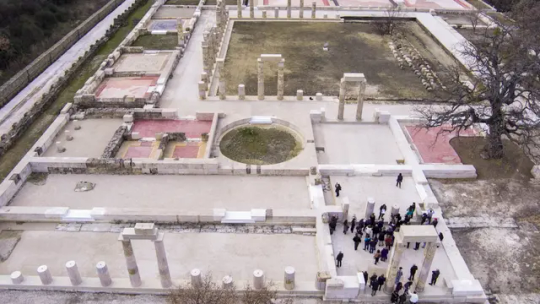
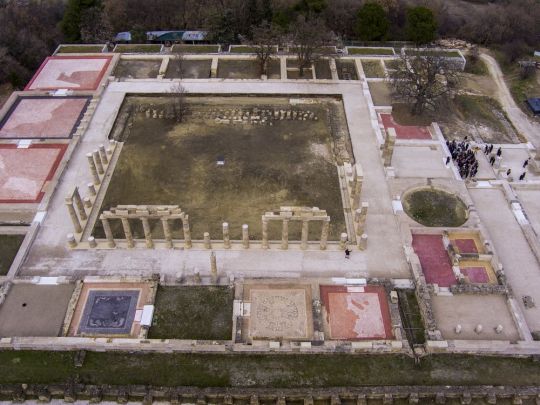
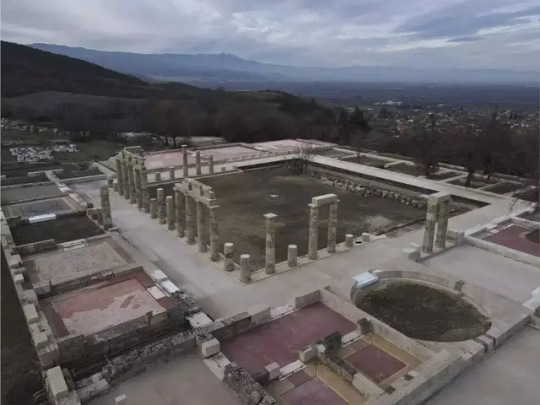
Greece Reopens the 2,400-Year-Old Palace Where Alexander the Great Was Crowned
The 2,300-year-old Palace of Aigai—the largest building in classical Greece—had been under renovation for 16 years.
On the day he was crowned king of Macedonia, Alexander the Great stood atop the intricately patterned marble floors of the Palace of Aigai. This week, the historic palace finally opened to the public after a 16-year-long restoration, report Derek Gatopoulos and Costas Kantouris of the Associated Press (AP).
At 160,000 square feet, the Palace of Aigai was classical Greece’s largest structure. Built primarily by Alexander’s father, Phillip II, in the fourth century B.C.E., it was the home of the Argead dynasty, ancient Macedonia’s ruling family. It was destroyed by the Romans in 148 B.C.E. and endured a subsequent series of lootings. Renovating and excavating this sprawling monument was a serious undertaking, costing over 20 million euros ($22 million).
The Greek government was able to maintain the “general appearance” of the site amid careful alterations to the monument’s towering marble columns, delicate mosaics and textured flooring, according to Xiaofei Xu and Chris Liakos. The palace once featured large column-lined courtyards, worship sites and expansive banquet halls, and its restoration presented a “three-dimensional jigsaw puzzle,” per the AP. Archaeologists solved it by combining stones from the structure’s ruins with replica parts to reproduce the original structures.
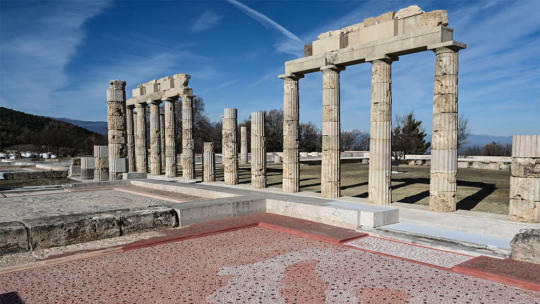
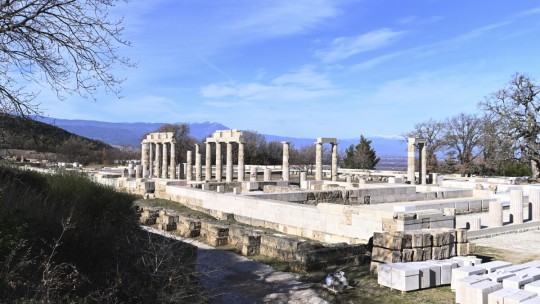
Archaeologist Angeliki Kottaridi started working on the renovation efforts as a university student. Overseeing the project’s progress over many years and contributing to its excavation and reconstruction, Kottardi became a leading figure in the project.
“What you discover is stones scattered in the dirt, and pieces of mosaics here and there,” Kottaridi told state television before an opening ceremony on Friday, per the AP. “Then you have to assemble things, and that’s the real joy of the researcher.”
The Palace of Aigai is located in northern Greece between what are now the towns of Palatitsia and Vergina. Its reopening builds on discoveries made in the late 1970s by Greek archaeologist Manolis Andronikos, who unearthed a cluster of royal Macedonian artifacts, including gold and silver ceremonial weapons and armor, and burials, one of which is thought to contain Phillip’s remains. The palace and its neighboring tombs are now a UNESCO World Heritage site.
Deeming it “among the most important archaeological sites in Europe,” UNESCO writes that the Palace of Aigai “represents an exceptional testimony to a significant development in European civilization, at the transition from the classical city state to the imperial structure of the Hellenistic and Roman periods.”
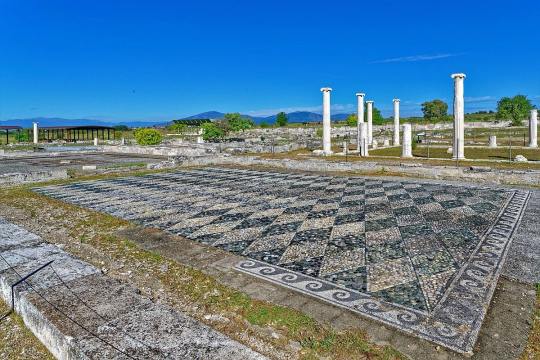
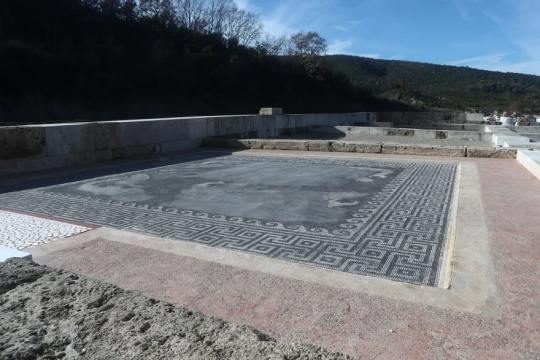

As the site of the first capital of the ancient kingdom of Macedonia, the Palace of Aigai signifies the onset of Alexander’s rule, which would stretch from Asia to the Middle East, and provides a crucial window into Macedonian culture.
“The importance of such monuments transcends local boundaries, becoming property of all humanity,” said Kyriakos Mitsotakis, Greece’s prime minister, at the inauguration event, per CNN. “And we as the custodians of this precious cultural heritage, we must protect it, highlight it, promote it and at the same time expand the horizons revealed by each new facet.”
By Catherine Duncan.
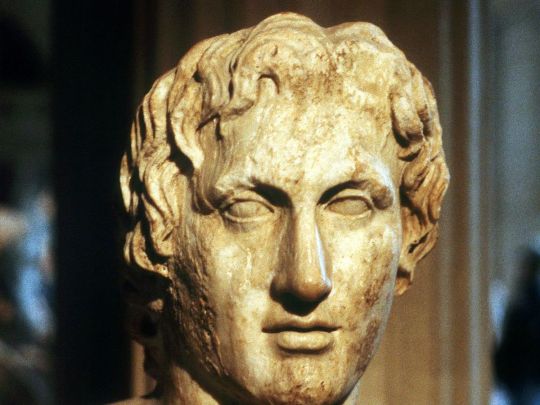
#Greece Reopens the 2400-Year-Old Palace Where Alexander the Great Was Crowned#Palace of Aigai#Argead dynasty#Phillip II#ancient artifacts#archeology#archeolgst#history#history news#ancient history#ancient culture#ancient civilizations#ancient macedonia#ancient greece#greek history#greek art
93 notes
·
View notes
Text
Recently uploaded *brief* (1-page, 2-column) description of the Aigai palace by Angeliki Kottaridi (Director of the 17th Ephorate of Antiquities, Imathia, which is where Pella and Vergina are located).
2 notes
·
View notes
Text

A beautiful pebble mosaic floor of the Palace of Aigai, which was built during the Phillip II’s reign (359-336 BC). The Palace of Aigai is the largest scale building of the Ancient Greece, located in the city of Vergina, Central Macedonia, Greece.
Photo by © Angeliki Kottaridi, shared via The Mind Circle
▶️ https://themindcircle.com/ancient-mosaics/
1 note
·
View note
Text
Smithsonian Magazine June 20 issue: "The king and the conqueror" by Richard Grant
Smithsonian Magazine June 20 issue: “The king and the conqueror” by Richard Grant
Happy Sunday everyone, thank you for being on Alessandro III di Macedonia- your source about Alexander the Great. Today I’d like to warn you that on the current issue, June 20, of Smithsonian Magazine there’s something you might be interested in:

You’ll find an article by Richard Grant (photographs by Myrto Papadopoulos) entitled The King and the Conqueror:
Alexander the Great’s unmatched…
View On WordPress
1 note
·
View note
Text
NUOVE SCOPERTE DA AEGAE/AIGAI, MACEDONIA, GRECIA
NUOVE SCOPERTE DA AEGAE/AIGAI, MACEDONIA, GRECIA
Negli ultimi tre anni, nell’ambito della ricerca dell’Hemathia Ephorate of Antiquities per lo studio del mantenimento del grande complesso edilizio di Aegae/Aigai, nella Macedonia greca, situato in prossimità della porta nord-ovest del muro e del gruppo delle tombe delle regine, sono venuti alla luce nuovi edifici estremamente interessanti e reperti con particolari iscrizioni. Secondo Angeliki…

View On WordPress
0 notes
Text
Forgotten Sculpture of Alexander the Great Found in Greek Museum’s Storage

An ancient sculpture of Alexander the Great was recently discovered in a Greek museum’s storage room, a leading archaeologist revealed recently on Facebook.
Angeliki Kottaridi said the sculptural portrait of the Macedonian king had been forgotten for years in the warehouses of the Archaeological Museum in the town of Veria, in northern Greece.
She added that this “brand new” portrait of Alexander the Great is unknown to archaeologists and historians.
“It was lost for decades, hidden in a dark corner of the warehouse amidst pottery cages and dirt,” Kottaridi stated in amazement. Read more.
289 notes
·
View notes
Text
Nuova statua di Alessandro Magno trovata nei magazzini di un museo
Nuova statua di Alessandro Magno trovata nei magazzini di un museo
Buon pomeriggio a tutti, questa non è una scoperta archeologica vera e propria, però è un ritrovamento singolare e soprattutto ha dell’incredibile (almeno secondo me). Nei magazzini del Museo Archeologico di Veria hanno ritrovato questa statua dimenticata di Alessandro Magno. Questa statua cadde nel dimenticatoio non si sa bene quando, come e perché. A dare la notizia di questo incredibile…
View On WordPress
0 notes
Text
Lost Alexander the Great sculpture found in storage room
Lost Alexander the Great sculpture found in storage room


An ancient sculpture of Alexander the Great was recently discovered inside the storage room of a Greek museum.
The surprising find was made by Angeliki Kottaridi, a leading archaeologist and announced in a Facebook post.
“A ‘brand new’ Portrait of Alexander, still unknown to archaeologists and art lovers… For decades lost in a dark corner of the warehouse of the archaeological museum of Veria…
View On WordPress
0 notes
Photo






Books/ The Royal Tombs of Aigai:
Finds from the tomb of Alexander IV- son of Alexander the Great. (310 B.C) Alexander IV was about twelve years old at the time of his death. He was assassinated along with his mother Roxanne by order of Cassander, one of the diadochi.
A collection of silver banqueting utensils and vessels entombed with the prince.
Wall paintings from the frieze of the tomb depicting charriot racing. The silver cinerary hydria of Alexander IV with his oak wreath.
Decorative ivory and gold figures from the couch the prince was burned on.
From the book Aigai, the royal metropolis of the Macedonians, by Angeliki Kottaridi. Photography: Socrates Mavrommatis. (You can peruse the book here)
#Aigai#Aigai: the royal metropolis of the Macedonians#the Multicenter Museum of Aigai#publications for Aigai#Angeliki Kottaridi#greek museums#archaeological museums#Ancient Greece#Ancient Macedonia#Vergina#Imathia#Macedonia#Greece#Αιγαί#Αιγαί: Η βασιλική μητρόπολη των Μακεδόνων#Το Πολυκεντρικό Μουσείο Αιγών#εκδόσεις για τις Αιγές#εκδόσεις#βιβλία#publications#books#Αγγελική Κοτταρίδη#ελληνικά μουσεία#αρχαιολογικά μουσεία ελλάδας#Αρχαία Ελλάδα#Αρχαία Μακεδονία#Βεργίνα#Ημαθία#Μακεδονία#Ελλάδα
104 notes
·
View notes
Text
Piccole news di un libro, un catalogo di una mostra e... auguri Alessandro
Piccole news di un libro, un catalogo di una mostra e... auguri Alessandro #AlessandroMagno #AlessandroilGrande #AlexanderTheGreat #alessandroilmacedone #AlessandroIIIdiMacedonia #alexandertheconqueror
Buongiorno a tutti, oggi ho due o tre cose da segnalarvi e da dirvi. Primo per importanza vorrei ricordare la nascita del nostro grande personaggio preferito: infatti
2375 anni fa nacque Alessandro III di Macedonia,
detto Magno. L’ho già detto molte volte e lo dirò ancora perché non finirò di stupirmene di come una persona vissuta più di due millenni fa influenzi ancora così tante persone.…
View On WordPress
0 notes
Photo






Books/ The Royal Tombs of Aigai:
Finds from the tomb of Philip II of Macedon and the Scythian princess Meda, in Aigai, Macedonia, Greece.
The gold sheet that decorated the gorytos (a Thraco-Scythian quiver that held both the bow and the arrows). It was either a gift or booty. It might be related to the Philip's marriage with Meda. It bears a depiction of the fall of a city- Troy perhaps.
The golden diadem of the princess has been partially destroyed by the funeral pyre. It was set with inlaid blue glass paste, and had small springs that made certain elements quiver with motion.A piece of gold and purple textile that covered the princess' bones inside the larnax.
Ceremonial armour, shield and sword of Phillip II. A detail from the golden larnax of Philip II, and a general view of how it's displayed in the museum along with Philip's golden wreath.
From the book Aigai, the royal metropolis of the Macedonians, by Angeliki Kottaridi. Photography: Socrates Mavrommatis. (You can peruse the book here)
#Aigai#Aigai: the royal metropolis of the Macedonians#Angeliki Kottaridi#the Multicenter Museum of Aigai#greek museums#archaeological museums of Greece#macedonian tombs#princess Meda#Philip II of Macedon#Vergina#Imathia#Greece#Αιγαί#Αιγαί: Η βασιλική μητρόπολη των Μακεδόνων#Το Πολυκεντρικό Μουσείο Αιγών#Αγγελική Κοτταρίδη#Σωκράτης Μαυρομμάτης#Socrates Mavrommates#Βεργίνα#Ημαθία#Μακεδονία#Ελλάδα#Αρχαία Ελλάδα#Αρχαία Μακεδονία#Ancient Greece#Ancient Macedonia#ελληνικά μουσεία#αρχαιολογικά μουσεία ελλάδας#μακεδονικοί τάφοι#βιβλία
1K notes
·
View notes
Photo


Books/ The Royal Tombs of Aigai:
The tomb of Queen Eurydice, mother of Philip II of Macedon and grandmother of Alexander the Great. She was entombed along with this splendid throne that bears a depiction of Hades and Persephone riding on a charriot towards the underworld (344-343 B.C). You will notice how calm and orderly this depiction is compared to this sensational mural from the tomb with the abduction of Persephone, in which possibly Nikesipolis is entombed.
Ancient Macedonians burned their deceased rulers in funeral pyres, then washed the bones with wine and stored them in golden larnakes in funerary buildings along with their personal effects. The mausoleums were then covered under mounts of earth. For this reason a lot of the objects found in tombs, such as the wreaths, show damage from fire. The deceased wore their wreaths and jewellery when they were burned.
Picture from Aigai, the royal metropolis of the Macedonians, by Angeliki Kottaridi. Photography: Socrates Mavrommatis (You can peruse it here)
#Aigai#Aigai: the royal metropolis of the Macedonians#the Multicenter Museum of Aigai#publications for Aigai#Angeliki Kottaridi#books#ancient painting#ancient greek painting#furniture#burial customs#burial habits#macedonian tombs#macedonian funerary painting#Vergina#Imathia#Macedonia#Greece#greek museums#archaeological museums of Greece#Αιγαί#Αιγαί: Η βασιλική μητρόπολη των Μακεδόνων#Το Πολυκεντρικό Μουσείο Αιγών#εκδόσεις για τις Αιγές#βιβλία#Αγγελική Κοτταρίδη#αρχαιο��λληνική ζωγραφική#αρχαία ζωγραφική#έπιπλα#ancient furniture#επιπλοποιία
151 notes
·
View notes
Photo


Books/ The Royal Tombs of Aigai:
Two pieces of exquisite gold and purple textile.The bones of princess Meda- a woman between 20-25 years old- were carefully wrapped in them, and placed inside a golden larnax. It has been theoriticized that princess Meda committed suicide after the assassination of Philip II, according to a scythian custom that dictated the wives of esteemed men follow them to their death. However, given the political climate of the time, it's not unlikely that the princess was assassinated as well, or forced to commit suicide. Angeliki Kottaridi leans towards the case of a voluntary suicide. She suggests that this act impressed the Macedonians so much, even raising her perhaps to the status of a new Alkestis. Princess Meda was not only buried along splendid gifts, but she was also buried along Philip II, thus possessing the status of his sole wife in the underworld.
Pictures from Aigai, the royal metropolis of the Macedonians, by Angeliki Kottaridi. Photography: Socrates Mavrommatis. (You can peruse the book here)
#Aigai#Aigai: the royal metropolis of the Macedonians#the Multicenter Museum of Aigai#Angeliki Kottaridi#textiles#ancient textiles#princess Meda#Vergina#Imathia#Macedonia#Greece#greek museums#books#publications for Aigai#archaeological museums of Greece#Αιγαί#Αιγαί: Η βασιλική μητρόπολη των Μακεδόνων#Το Πολυκεντρικό Μουσείο Αιγών#Αγγελική Κοτταρίδη#υφάσματα#αρχαία υφάσματα#Μήδα#Βεργίνα#Ημαθία#Μακεδονία#Ελλάδα#ελληνικά μουσεία#αρχαιολογικά μουσεία ελλάδας
42 notes
·
View notes
Photo




Books/ The Royal Tombs of Aigai:
Wall painting from the facade of a tomb that housed the remains of Philip II of Macedon and the Scythian princess Meda. The frieze depicts the royal hunt within a forest. The figure clad in purple, wearing a golden wreath has been suggested that is Alexander the Great. The figure at the right, on horseback, attacking a lion, left of a figure clad in red, has been suggested that is Philip II. (336 B.C)
Picture from Aigai, the royal metropolis of the Macedonians, by Angeliki Kottaridi. Photography: Socrates Mavrommatis
The book was a limited prints edition (just 370 copies), issued by the Olkos group, under the auspice and partial funding of the John S. Latsis Public Benefit Foundation. (you can peruse it here)
#Aigai#Aigai: the royal metropolis of the Macedonians#Angeliki Kottaridi#Vergina#Imathia#Macedonia#Greece#ancient greek painting#ancient painting#Ancient Greece#Ancient Macedonia#greek museums#the Multicenter Museum of Aigai#alexander the great#macedonian tombs#macedonian funerary painting#Αιγαί#Αιγαί: Η βασιλική μητρόπολη των Μακεδόνων#Αγγελική Κοτταρίδη#Βεργίνα#Ημαθία#Μακεδονία#Ελλάδα#αρχαιοελληνική ζωγραφική#αρχαία ζωγραφική#Αρχαία Ελλάδα#Αρχαία Μακεδονία#ελληνικά μουσεία#Το Πολυκεντρικό Μουσείο Αιγών#Μέγας Αλέξανδρος
52 notes
·
View notes